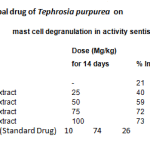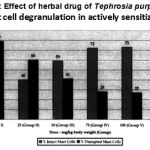Manuscript accepted on :November 24, 2008
Published online on: 09-11-2015
Plagiarism Check: Yes
Sunita Sharma, Kapil Kumar Soni, R. C. Saxena, Rahul Saxena*, Sarika Shrivastava and R. T. Paliwal.
1Pest Control and Ayurvedic Drug Research Laboratory, Department of Zoology, S.S.L. Jain P.G. College, Vidisha (India).
2College of Pharmacy, IPS Academy, Indore (India).
3LNCT College of Pharmacy, Bhopal (India).
Abstract
Ayurveda, an ancient system of Indian medicine has recommended a number of drugs from indigenous plant sources for teh treatment of bronchia asthma and allergic reactions. Importance of natural products in modern pharmacology is decreasing and a substantial part of drugs are still based on compound orginially isolated from the natural products. Many pharmacologically active natural products isolated from plants which have beenused in traditional medicine. Someplants have been reported in India for antiasthmatic, antihistaminic and smooth muscles relaxant activities including Achyranthes, Eclipta, Balanites, Viscum. Tephrosia purpurea of family Leguimosae popularly known as "Sarpunkha" has been used in Ayurvedic medicine as cardiac stimulatant. In the present laboratory antihistaminic activity has been tested in the experimental guinea pigs in which asthma was induced by horse serum (0.5 ml). Subcuntenously for 14 days duration. The effect of the herbal extract isolated from the stem of the plant was noticed inteh kymogrpah followed by tracheal chain prepartion method. Maximum effect was noticed in the kymograph at 4mg/kg body weight dose of alcoholic extract of Tephrosia purpurea.
Keywords
Ayurveda; Tephrosia purpurea; pharmacology
Download this article as:| Copy the following to cite this article: Sharma S, Soni K. K, Saxena R.C, Saxena R, Shrivastava S, Paliwal R.T.Pharmacology of an Ayurvedic Indian Medicinal Plant for Mast Cell Degranulation Activity. Biomed. Pharmacol. J.2008;1(2) |
| Copy the following to cite this URL: Sharma S, Soni K. K, Saxena R.C, Saxena R, Shrivastava S, Paliwal R.T.Pharmacology of an Ayurvedic Indian Medicinal Plant for Mast Cell Degranulation Activity. Biomed. Pharmacol. J.2008;1(2). Available from: http://biomedpharmajournal.org/?p=493 |
Introduction
Asthama is an allergic reaction mainly associated with air pollution and improper ventilation. Histamine secreted by the most cells plays an important role in the constriction of smooth muscles of airways. Their number increase during asthma which causes bronchospasm, thus narrowing down the respiratory passage.
In India, several medicinal plants have been traditionally used in the treatment of respiratory disease. Tripathi and Sas (1977) have mentioned the antiasthmatic activity of medicinal plants Albizzia labbeck. Bergendroff et al., (1995) have reported 7 European plants found useful in asthma. Mitra
et al., (1999) have reported a poly herbal formulation on degranulation of mesentic mast cell in albino rats. Abbasoglu and Tukog (1945) have reported that saponin having various pharmacological effects are widely distributed in plants.
In the present study, phytoparmacology of “Saponin” isolated from the leaves and stem of Tephrosia purpurea Linn of family Leguminosae was observed on smooth muscles (Tracheal) relaxant activity which in caused due to mast cell deregulation using guine pigs experimental model.
Experimental
Plant Material
Tephrosia purpurea Linn. of family Leguminosae is a shrub widely distributed throughout north and central part of India. The plant was identified by the Botanists of the Institute and a Voucher specimen was deposited in herbarium sheet of the laboratory at S. No. 7. The villagers of the remote areas of Raisen District of Madhya Pradesh in India have been using decoction of fresh leaves of this plant in severe cold, cough and throat infection (Khare and Saxena 1999). Fresh plant materials was collected from the villages of Raisen district, washed thoroughly and shade dried at room temperature.
Extraction and Isolation
40 to 60 mesh size powdered plant material was extracted in Soxhlet appratus using 90% ethanol and water successively. The percentage yield, ash content, moisture content, saponifiable value of the plant material was recorded (Table 1).
Table 1: Chemical characteristics of Tephrosia purpurea
| S.No | Characteristcs | Percentage in each |
| 1 | Percentage loss in weight on shade drying | 45 |
| 2 | Percentage of Ash contents | 33.4 |
| 3 | Water Soluble ash contents | 65 |
| 4 | Acid Soluble ash contents | 3.1 |
| 5 | Fibre value | Not more than 35 |
| 6 | Saponificable value | 70 |
| 7 | Percentage yield in 90% alcohol | 1.82 |
| 8 | Water | 3.86 |
 |
Table 2: TLC of alcoholic extract of Tephrosia purpurea.
|
 |
Table 3: Effect of herbal drug of Tephrosia purpurea on mast cell degranulation in activity sentisized guine pigs.
|
The crude extract was evaporated to dryness under low temperature and reduced pressure. The yield was recorded. The alcoholic extract was portioned successively and sub feeted to Si-gel ‘G’ cc using CHCl3- MeOH in different propotions. The fractions collected from CHCl3: MeOH (11 : 8) gave dard red needles of 120 mg with mp 236°C [M+] m/z 545; UV max 266, 325 nm. IR bands (Kbr – Elmar Model) gave 1664, cm-1.
¹H NMR (3000 MHz, CDCl3): d 7.81 (1 H, H2), 6.94 (1 H, S, H-8), 6.2 (1H, S, H-6), 7.12 (2H, S, H-2′ and H6′). ¹³C NMR (DMSO); 155.9 (C-2); 120.6 (C-3) 180.7 (C-4), 162.2 (C-5), 99.1 (C-6), 164.2 (C-7), 93.6 (C-8), 157.9 (C-9), 154.4 (C-2′), 115.6 (C-3′), 156.5 (C-4′), 76.0 (C-5′) and 60.4 (C-6′).
Biological assays
Male guinea pigs about 200 gm and kept under standard laboratory conditions were used in all experiments. They were maintained as per guidelines of CPSEA vide letter No. 804/CA/CPCSEA and IAEC. Asthma was included by injecting subconsciously 0.5 ml of Triple antigen and 0.5 ml of horse serum for 14 days. The sacrificed animals were divided in the sex groups with 3 in each. On day 14, they were stunned by blow on the head and exsanguinated. Trachea was dissected out, breed from other tissue and cut into two cartilage rings. Cotton threads were fastened to both ends of the cartilage bridge which was then cut open ventrally. The preparation was mounted in a water jacketed organ both in Ringer Locke solution. The mesenteries pieces were kept separately in the above solution and challenged with 5% horse serum for 10 mins. Mast cells were stained and examined microscopically for the number of intact and degranulated mast cells. Action of herbal extract on isolated guinea pig tracheal chain and contraction was recorded on smoked drum using frontal writing lever.
Results and Discussion
The results of the present study showed that two weeks after sensitization, the antigen challenge degranulated about 79% of the mast cells. When the sacrificed animals were treated with herbal drugs (25, 50, 75 and 100 mg/kg) for two weeks and then challenged with an antigen, there was a significant reduction in the number of distrupted mast cells. The effect of alcoholic extract at 100mg/kg dose was quite comparable to the prednisolone (Table 3). In the control group of actively sensitized animals, 79% disruption of mast cell was noticed whereas it came down to 27% in the treatment with 100 mg/kg dose of alcoholic extract of T. purpurea (Fig. 1). The extract also causes bronchoconstrictor in isolated guine pig tracheal chain.
 |
Figure 1: Effect of herbal drug of Tephrosia purpurea on mast cell degranulation in actively sensitized rats.
|
The results of the present study showed disruption in the mast cells due to which histamine is released which causes bronchospam formation and constriction of the tracheal muscels consequently causing asthmatic attack.
The alcoholic extract of Tephrosia proved to be highly effective in the sense that number of degranulated cells came down to 27%. Sharma (1976) have also reported such activities in Albizzia lebbeck. Gupta (1974) made antiasthamatic effect of saponin of Gardenia latifolia in rats. Mitra et al., (1999) have noticed the similar effects of E-721B in anaphylatic rats. Singh et al., (2008) have isolated 3,7,4′-trihydroxy flavon.
In the present study, extract of the aerial part of Tephrosia gave a dose dependent relaxation in tracheal muscels as well as cell stabilizing potential Maximum of 100 mg/kg body weight dose. The report of the present study support the findings of Agarwal and Mehta (2008) who have reported the safety and efficacy of seed kernel of Moringa oleifesa in the bronchial asthma. The phytochemistry of the isolated fraction was found to possess a ‘Tephrosap’ – a glycosidal triterpenoid saponin. This needs fester of biologically active compound.
Acknowledgments
Thanks are the MPCST for travel grants and to Head SAIF, CDRl, Lucknow for spectral analysis and Govt. of M.P., Higher Education Department for official permission to present the findings. Thanks are also due to CPCSEA, Chennai for permission use the albino rats for experimental work.
References
- Abbasoghu, U. and Turkog, S. Antimicrobial activity of saponin extract from some Indigenous plants of Tuskey. Int. J. Pharmacognosy. 33(4) 293-296.
- Agarwal B. and Mehta A. Antiasthmatic activity of Morgina oleifen Linn clinical study. Indian J. Pharmacol, 40(1): 28-31 (2008).
- Bergandroff, O., Franzen, C. and Woldeck, B. Screening of some Europeon medicinal plant for spasmolytic activity on isolated guinea pig trachea. Int. J. Pharmacognocy, 30(4): 356-358 (1945).
- Gupta, S.S., Some observation on the antiasthmatic effect of saponin of Gardenia latifolia aspect of allergy. Applied Immunology, 7: 198-201 (1974).
- Khare, M.L and Saxena, R.C. Screening of a herbal medicine Tephrosia purpurea (Leguminosae) for bronchial asthma. J of the National Integrated Medicinal Association. 41(4): 7-9 (1999).
- Mitra, S.K., Gopumodhavan S., Venkataranga, M.V. and Anturilikar, S.D., Antisathmatic and anaphylactic effect of E-721B-a herval formulation. Indian J of Pharmacology. 31: 133-137 (1999).
- Padmalatha, K. Venkataraweu, B.V., Roopa R. Effect of poly herbal formulation on rat mesenteric mast cell degranulation. Indian J of Pharmacology. 32: 7-10 (2000).
- Sharma, O.D., Clinical and experimental studies on bronchial asthma (Tamakashvase) with special reference to it management with Albizza lebbrck benth (Shireesha), D. Ay. AM. Thesis, Banaras Hindi University, Varanasi, Indian. (1976).
- Singh Vandava, Singh A.K. and Saxena R.C. Isolation of flavonoid from rural based ethnomiedicinal plant Tephrosia purpurea of family Leguminosae. J of Rerul Technology. In press (2008).
- Tripathi, R.M. and Das, P.K., Studies on antiasthamatic and anti anaphylactic activity of Albizzia libbek. Indian J of Pharmacology, 9: 189-194 (1977).







